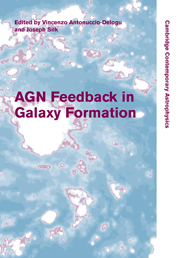Book contents
- Frontmatter
- Contents
- List of contributors
- Preface
- The organising committees
- Part I AGNs, starbursts and galaxy evolution
- Part II Co-evolution of black holes and galaxies
- Part III Outflows and radio galaxies
- Part IV Models and numerical simulations: methods and results
- 12 Physical models of AGN feedback
- 13 Large-scale expansion of AGN outflows in a cosmological volume
- 14 Relativistic jets and the inhomogeneous interstellar medium
- 15 AGN feedback effect on intracluster medium properties from galaxy cluster hydrodynamical simulations
- 16 Physics and fate of jet-related emission line regions
- 17 Cusp–core dichotomy of elliptical galaxies: the role of thermal evaporation
- Index
15 - AGN feedback effect on intracluster medium properties from galaxy cluster hydrodynamical simulations
from Part IV - Models and numerical simulations: methods and results
Published online by Cambridge University Press: 10 November 2010
- Frontmatter
- Contents
- List of contributors
- Preface
- The organising committees
- Part I AGNs, starbursts and galaxy evolution
- Part II Co-evolution of black holes and galaxies
- Part III Outflows and radio galaxies
- Part IV Models and numerical simulations: methods and results
- 12 Physical models of AGN feedback
- 13 Large-scale expansion of AGN outflows in a cosmological volume
- 14 Relativistic jets and the inhomogeneous interstellar medium
- 15 AGN feedback effect on intracluster medium properties from galaxy cluster hydrodynamical simulations
- 16 Physics and fate of jet-related emission line regions
- 17 Cusp–core dichotomy of elliptical galaxies: the role of thermal evaporation
- Index
Summary
Introduction
High-quality data from X-ray satellites have established a number of facts concerning the statistical thermo- and chemo-dynamical properties of the intracluster medium (ICM) in galaxy clusters. In particular, core regions of relaxed clusters show little evidence of gas cooler than a third of virial temperature (e.g. Peterson et al. 2001), temperature profiles display negative gradients outside the core region (e.g. Vikhlinin et al. 2005; Leccardi and Molendi 2008b) and the distribution of iron in the ICM shows a negative gradient, which is more pronounced for relaxed ‘cool core’ clusters (e.g. Vikhlinin et al. 2005; Leccardi and Molendi 2008a).
The above observational properties of the ICM arise from an interplay between the cosmological scenario of building up the large-scale structure and a number of astrophysical processes (e.g. star formation, energy and chemical feedback from supernovae and AGN) taking place on much smaller scales. Such issues can be addressed using cosmological hydrodynamical simulations where the complexity of relevant astrophysical processes can be described as the result of hierarchical assembly of cosmic structures (e.g. Borgani et al. 2008).
The generally accepted solution to the shortcomings of simulations is represented by AGN feedback. The presence of cavities in the ICM at the cluster centre is considered as the fingerprint of the conversion of the mechanical energy associated with AGN jets into thermal energy (and possibly in a non-thermal content of relativistic particles) through shocks (e.g. McNamara and Nulsen 2007).
- Type
- Chapter
- Information
- AGN Feedback in Galaxy Formation , pp. 175 - 182Publisher: Cambridge University PressPrint publication year: 2010

